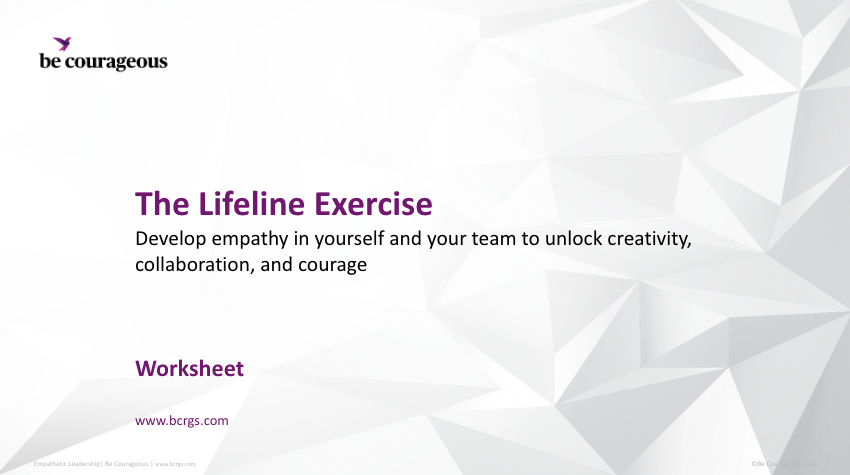How cultivating empathy can amplify morale, collaboration, and innovation in an entire organization.
In our work worldwide, we’re often called upon to measure and assess various skills, talents, and mindsets within companies and teams.
Measuring empathetic accuracy
One of the areas we measure, which has a direct effect on successful workplace dynamics and performance, is called, “empathetic accuracy.”
A team’s empathetic accuracy score shows their adept at putting aside their biases and interpreting how others feel.
As you can imagine, teams who score high on this scale work well together with low conflict, and teams who score low on this scale suffer difficulty with collaboration.
What we’ve been seeing across the board is that even though humans have an innate desire for human connection, companies across every industry are scoring lower than ever on the empathetic accuracy factor.
Conversely, scores we’re seeing higher-than-ever scores in growth focus and determination. Companies are focused on results and the quest for more, signaling a trend toward individualism and siloed ways of working to achieve those outcomes.
The problem with this combination? We’re humans, after all, not robots (for now!). A team’s skillset could be extraordinary on paper, but if they can’t work together well, everyone will stay stuck.
Let’s dig into why this pattern has emerged, and how empathy can unlock more courage, collaboration, and creativity in yourself and your team.
The rise of fear = the decline of empathy
Most people are healing from parts of their past; I’ve noticed in many companies there is what I’ve called, a “wounded workplace.” And with the future more uncertain than ever, higher levels of fear and skepticism abound.
A rise in fear = a decrease in empathy.
Why? When we’re grieving loss and afraid of the future, or are dubious of others because of past hurts, we rewire ourselves for self-protection and survival mode.
In a state of fear and suspicion of future danger, people move to a self-preservation mode, disconnecting from others.
This self-protective mindset is a huge block to flow. Empathy is the answer.
What is empathy?
Empathy is the power to not only feel for but feel with others.
Empathy goes beyond sympathy.
Sympathy might say, from a distance, “That must suck for you.”
Empathy says, “I get it and I’m feeling with you right now. I know how you feel because I’ve felt the same way (or been in the same situation).”
Lack of empathy problems
A lack of empathy in leadership and teams leads to:
- Miscommunication (from lack of understanding).
- Lower productivity and motivation (why work hard when no one notices?).
- Reduced collaboration (it’s hard to collaborate at a distance).
- Higher turnover rates (employees who don’t feel they’re understood or belong will go somewhere else).
- Isolation and loneliness (people working in silos).
- Lower morale (distrusting colleagues aren’t going to be joyful team players).
- Increased burnout (lack of emotional support creates more stressful conditions).
- Poor decision-making (a stressed, protective mindset won’t lead to the most mindful decisions).
- Poor conflict resolution (without understanding others, teams will have a harder time-solving problems).
- Lack of innovation (a welcoming of different perspectives is required to consider new ideas).
- Damaged team reputation (a team that lacks empathy can come across as cold and unapproachable, which can hurt their reputation both internally and externally).
If you’ve read these issues and are nodding your head thinking, Yep, I’ve got a few of these going on, take a moment here to take a deep breath in. We’ve been there with countless teams and we’ve always found a way to improve the situation.
Leaders who want cohesive, innovative teams must make empathy a cornerstone of their leadership approach.
Empathy benefits
Think about the teams you’ve most enjoyed leading, working with, or working within. They’re likely teams you felt you had a real connection with (not just transactional). Those were probably also the teams that got the most done together in both tactical and creative pursuits.
Empathy doesn’t just resolve conflicts; it opens up space for creativity and innovation.
A team that feels safe to express themselves, share ideas, and take risks is more likely to develop create, and invent solutions.
Empathetic teams will help each other out, pitching in because they understand each other’s needs, reducing burnout and stress.
When leaders make an effort to understand their team members’ viewpoints, they enable more collaborative brainstorming and problem-solving and generate a higher level of psychological safety.
Empathy fuels trust, and trust drives innovation.
A strong, empathic team will not only be more productive but also build resilience, as each member feels supported to handle the inevitable challenges ahead.
Empathy builds resilience
Have you ever heard the sayings, “You’re only as good as your worst day,” “Your company is only as good as your weakest employee,” or, “You’re only as happy as your saddest child?”
A team’s vibe will always calibrate to the lowest denominator. If one person is off, the whole team will adjust downward. Everyone will drop their energy to match. This makes sense; it would feel strange to express positivity and enthusiasm when your teammate next to you has their shoulders slumped and is doodling the word “Ugh” in various fonts all over their paper.
Psychological studies have proven that negativity is a more powerful force than positivity. To overcome this bias, teams who can support each other are the strongest.
Practicing empathy means slowing down, listening without distraction, and giving people the time and attention they deserve. In meetings, this might mean encouraging team members to share more about their experiences, ideas, or concerns, making sure every voice is heard.
The extra few minutes it takes to be a caring human will come back 100-fold when it comes to support, collaboration, and performance.
Think about the power of a smile; when you smile at someone it changes their mood, and vice versa. Those micro-moments can have a massive impact.
How do we scale empathy?
The obvious big challenge is what you’re probably thinking right now—how to scale empathy in a world of technological solutions, screens, and digital interactions.
To scale anything, you have to look at the system first.
In the shift to hybrid and remote work, without daily in-person interactions that naturally build camaraderie, and coworkers becoming just names on a screen, empathy can be harder to practice. But it can be done.
Here’s how to intentionally build empathy into your leadership approach and within your team.
Be authentic and proactive. Integrity and openness will build trust. This means not only having open-door policies but actively checking in, listening to feedback, and addressing concerns. Honesty and transparency foster a culture where people feel valued, supported, and motivated. Think WYSIWYG here, (What You See is What You Get)—don’t lead with smoke and mirrors.
Show vulnerability. Leaders can set an example by sharing their own challenges, setbacks, or lessons learned. When you show you’re also human, it creates a safe space for others to do the same. Vulnerability cultivates empathy, as people become more open to understanding each other’s experiences.
I’ve been in numerous rooms lately where vulnerability from a leader has been a game-changer in how a team operates. There’s a remarkable energy shift. After a leader shares, there’s more connectivity, communication, and trust. That’s the perfect moment to create something together. In a climate of psychological safety (the effect of the power of vulnerability), people’s minds start to imagine what is possible in their work, further and further out in the future.
Offer mentorship opportunities. Mentorship allows employees to develop closer relationships and see through the eyes of someone else. Leaders can also establish peer support programs, where employees can lean on each other for advice and motivation.
Create connections in physical and digital environments. While digital tools may boost productivity, they often hinder meaningful human interactions. The more that technology takes center stage in our lives, the less empathetic our society has become.
Make an effort to maintain human-centered communication, even in a digital space. When you send your next direct message, before you get to your ask, add a genuine check-in and ask how your colleague is doing, how their weekend was, or how their kids are. Remember their answers for next time (take notes if needed.) Note: Do not do this if you don’t have time to truly listen (remember, it must be authentic).
In-person spaces can also be improved for human connection. I’ve noticed many companies lately are changing the flow of office layouts, embedding more places of casual connection (like expanding a lounge or cafeteria). These companies are noticing a rise in employee and cultural health scores as a result. Even executives are opting to have serious conversations in a more cafe-style meeting environment versus a private conference room.
Start with you
The best way to make a positive ripple and impact (in any domain) is by starting within yourself.
I have yet to meet a leader (or any adult!) who hasn’t gone through deeply challenging times. Whether it’s hardship in childhood, poverty, being forced to grow up too fast, or health issues, difficulties can put you in a perpetual survival mode.
What you may not realize is that you probably don’t need to be in survival mode anymore. Often (not always, of course), current conditions do not reflect the need to fight or self-protect. You’re through the fires of your past, and while I can’t promise there won’t be more in the future, try taking a look at your environment now, and lean into any financial, familial, community, or resource peace you have now.
Empathetic Leadership Tool: The Lifeline Exercise
A recent leader I worked with had a reputation for being strict, stoic, and unapproachable. Courageously, they went through the lifeline exercise with an open heart, and in front of their team! I cannot tell you how powerful it was for this leader to let down their guard and show their team their inner self.
Since that exercise, the executive’s team members have shared with me how opening up to empathy (starting from within) profoundly changed this leader’s mindset and management style. The entire team has been able to naturally be more open, and collaborative ever since. And with new trust formed, the leader confidently delegates more authority, and more creative ideas are shared openly.
Another time I did this exercise with a team, afterwards, they looked at each other differently. The team dinner that evening was one of the coolest experiences to witness. I saw relationships blossom. There was more laughter, deeper connections, and bigger, more courageous conversations.
You are the sum of everything you’ve experienced. The lifeline exercise will help you see your worth, that you can be kind to yourself, and that you’ve built a lot of positive attributes from the positive and negative experiences of your past.
In this exercise, you may also realize you have traits (skepticism, cynicism, distrust, a forceful nature) that served you in a prior experience but don’t necessarily serve you now.
Everyone has a story. When you understand that everyone you work with also has a story, probably as complex as yours, you can change how you show up for each other. With a team like that, empathy is at its core, and the sky is just the beginning.
Need an empathetic leadership courage guide to help you or your team connect? We’re here to help.
The Lifeline Exercise Tool
Discover your inner strengths and develop empathy with this life-reflecting exercise.
Co-written/edited: Shannon Geher
Research/images: FIN
References:
(1) Waldinger, R. (2015, November). What makes a good life? Lessons from the longest study on happiness [Video]. TED.
(2) Rozin, P., & Royzman, E. B. (2001). Negativity bias, negativity dominance, and contagion. Personality and Social Psychology Review, 5(4), 296-320. doi:10.1207/S15327957PSPR0504_2


